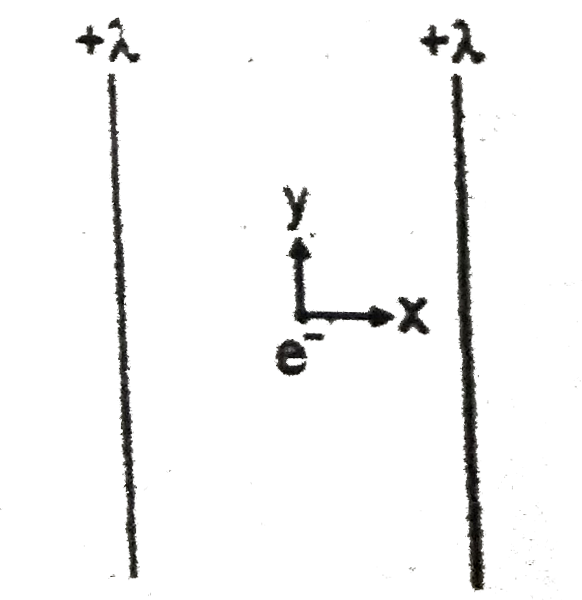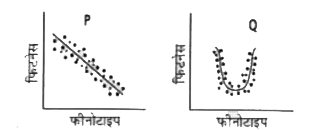Two identical samples (same material and same amout) PandQ of a radioactive substance having mean life T are observed to have activities AP and AQ respectively at the time of observation. If P is older than Q, then the difference in their age is
Tln(ApAQ)
Tln(AQAP)
1Tln(APAQ)
T(APAQ)
The correct Answer is:B
AP=AQe−γt=A0e1Tt ∴t=Tln(AQ)AP
Topper's Solved these Questions
Similar Questions
An electron is placed just in the middle between two long fixed line charges of charge density +λ each. The wires are in the xy plane (do not consider gravity)

View SolutionThe distance of an object from the pole of a concave mirror is equal to its radius of curvature. The image must be:
View SolutionThe mean of 1,7,5,3,4 and 4 is m. The observation 3,2,4,2,3,3 and p have mean (m-1) and median q. find p and q.
View SolutionThe mean of 1,7,5,3,4 and 4 is m.The observation 3,2,4,2,3,3 and p have mean (m-1) and median q. find p and q.
View SolutionFor a radioactive meterial , its activity A and rate of charge of its activity R are defined as A = - (dN)/(dt) and R = (dA)/(dt) where N(t) is the number of nuclei at time I .Two radioactive source P (mean life tau ) and Q(mean life 2 tau ) have the same activity at t = 2 tau R_(p) and R_(Q) respectively , if (R_(p))/(R_(Q)) = (n)/(e)
View SolutionTwo identical samples (same material and same amout) P and Q of a radioactive substance having mean life T are observed to have activities A_P and A_Q respectively at the time of observation. If P is older than Q, then the difference in their age is
View SolutionFor a radioactive material, its activity A and rate of change of its activity of R are defined as A=−dNdt and R=−dAdt, where N(t) is the number of nuclei at time t. Two radioactive source P (mean life τ) and Q (mean life 2τ) have the same activity at t=0. Their rates of activities at t=2τ are Rp and RQ, respectively. If RPRQ=ne, then the value of n is:
View SolutionTwo metalic spheres p and Q are made of same material have same smoothness but the weight of p is 8 times that of Q if the two are heated to same temperature and left to cool then the ratio of rate of cooling of Q to that of p is
View SolutionThe Half life period of a radioactive element P is same as the mean life time another radioactive element Q. Initially both of them have the same number of atoms.
View Solutionदो अलग-अलग नमूनों में एक ही रेडियोसक्रिय समस्थानिक है क्या इन नमूनों की अलग-अलग सक्रियताएँ होना सम्भव है ? व्याख्या करें।
View SolutionSame quantity of ice is filled in each of the two metal containers P and having the same size, shape and wall thickness but made of different materials. The containers are kept in identical surroundings. The ice in P melts completely in time t1, whereas that in Q takes a time t2. The ratio of thermal conductivities of the materials of P and Q is
View Solutionसमान लक्षण के भिन्न फीनोटाइप्स वाले जीवो की फिटनेस, दो विभिन्न स्थितियों P व Q में भिन्न होती है। P एवं Q क्रमशः दर्शाते है-

View SolutionActivation A of a radioactive material and R of activation change respectively A=(-dN)/(dt) And R=(-dA)/(dt) The relationship is defined by where N (t) is the number of nuclei at time t. Two radioactive sources P ("औसत आयु" tau) And Q (average age 2tau ) Have the same activation at time t = 0. Their activity change rates time t=2tau Respectively R_(P) And R_(Q) , Is | If (R_(P))/(R_(Q))=(n)/(e) , Then the value of n is
View SolutionFor a radioactive material, is activity A and rate of change of its activity R are defined as A=dNdt and R=dAdt. Two radioactive sources P (mean life τ ) Q (mean life 2τ ) have the same activity at t = 0. Their rates of change of activities at t=2τ are RP and R0 respectively. if RpR0=ne, then the value of n is
View SolutionSame quantity of ice is filled in each of the two metal containers P and Q having the same size, shape and wall thickness but made of different materials. The containers are kept in identical surroundings. The ice in P melts completely in time t1 whereas that in Q takes a time t2. The ratio of thermal conductivities of the materials of P and Q is
View SolutionTwo identical samples (same material and same amout) P and Q of a radioactive substance having mean life T are observed to have activities AP and AQ respectively at the time of observation. If P is older than Q, then the difference in their age is
View Solution

